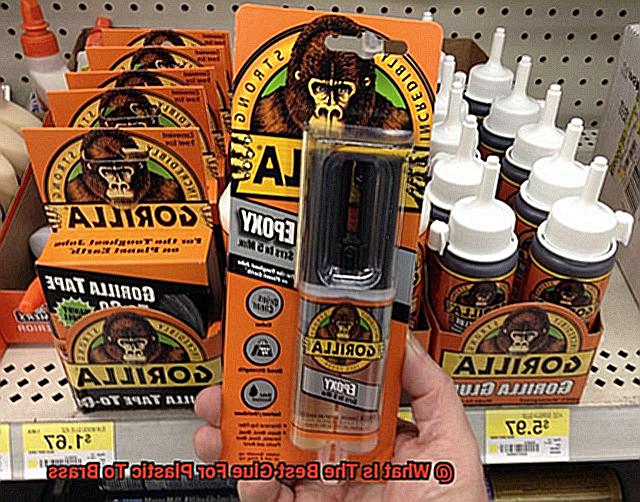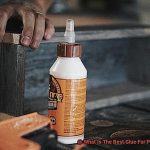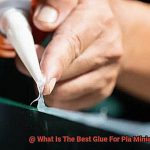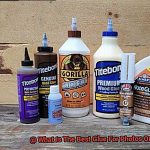Joining plastic and brass together can be a real head-scratcher. Whether you’re a DIY guru or a seasoned pro, finding the right glue for this tricky combo is crucial for achieving durable and dependable results.
But fear not. In this blog post, we’ll dive into the world of glues to help you find the perfect match. We’ll explore which adhesives offer super-strong bonding, incredible flexibility, and unbeatable resistance – all the factors that make for the best glue when it comes to plastic-to-brass projects.
So, if you’ve been on a quest for an adhesive that can withstand the test of time and create a seamless connection between plastic and brass, hold onto your hats as we embark on our adhesive adventure. Let’s discover the top contenders and find your ultimate glue companion for all your plastic-to-brass needs.
Types of Adhesives for Bonding Plastic to Brass
Contents
- 1 Types of Adhesives for Bonding Plastic to Brass
- 2 Considerations for Bonding Plastic to Brass
- 3 Epoxy: A Versatile and Strong Adhesive Solution
- 4 Super Glue: Fast-Curing and Strong Bond Strength
- 5 Polyurethane-Based Adhesives: Flexible and Resistant to Temperature Fluctuations
- 6 Preparing the Surfaces Before Applying Any Adhesive
- 7 Testing the Adhesive on a Small Area First
- 8 Considering Application Requirements
- 9 Conclusion
Look no further. In this article, we will delve into the world of adhesives and explore the different types that can be used for this purpose. Each adhesive brings its own unique strengths and weaknesses to the table, so let’s dive in and find the ideal glue for your project.
Epoxy Adhesives:
Epoxy adhesives are renowned for their exceptional bonding strength and remarkable resistance to heat and chemicals. They offer versatility and can effectively bond a wide range of plastics to brass surfaces. However, working with epoxy requires meticulous mixing and patience due to its longer curing time. Yet, the wait is worth it when you witness the robust bond it creates.
Cyanoacrylate Adhesives:
Known as super glues, cyanoacrylate adhesives provide instant adhesion and form strong bonds in a flash. They are easy to use but may not be suitable for all types of plastics or high-temperature environments. Before applying this adhesive, ensure compatibility with your materials to avoid any disappointments.
Polyurethane Adhesives:
If flexibility and resilience are what you seek, polyurethane adhesives are your answer. They offer excellent resistance to impact and vibration while bonding various types of plastics to brass effectively. Keep in mind that polyurethane adhesives may require longer curing times compared to other options, but their durability makes up for it.
Acrylic Adhesives (MMA):
Acrylic adhesives, particularly methyl methacrylate (MMA) adhesives, boast high-strength bonds and exceptional resistance to environmental factors like moisture and UV light. They are suitable for bonding a wide range of plastics to brass surfaces, making them a reliable choice for many applications.
Specialty Plastic-to-Brass Adhesives:
For those seeking a tailored solution, specialty adhesives designed specifically for bonding plastics to metals like brass are available. These adhesives chemically react with the plastic surface, creating an incredibly strong bond. However, it’s essential to note that not all plastics may be compatible, and the bond strength with brass may vary.
Considerations for Bonding Plastic to Brass
Bonding plastic to brass requires careful consideration of the properties of both materials and the selection of an appropriate adhesive. This guide will explore the key factors to consider when joining these two materials, ensuring a strong and durable bond. So, put on your lab coat and let’s delve into the world of adhesives.
Understanding the Properties:
Before we embark on our adhesive adventure, it’s crucial to understand the properties of plastic and brass. Plastic surfaces are typically smooth and non-porous, while brass can have a rough or textured surface. These differences can impact how adhesives bond with these materials.
Types of Plastics:
Plastics come in various types, such as polyethylene, polypropylene, PVC, and ABS, each with its own chemical composition. It’s important to consider the specific type of plastic being bonded to brass as different plastics may react differently with certain glues. Compatibility between the adhesive and the plastic is key to achieving a strong bond.
Choosing the Right Adhesive:
Now that we know our materials, let’s talk about adhesive options. There are several types available including epoxy, cyanoacrylate (super glue), and adhesive tapes. Each type has its own strengths and weaknesses when it comes to bonding plastic to brass. Consider factors such as bond strength requirements, application convenience, and environmental conditions before selecting the most suitable adhesive.
Application Method:
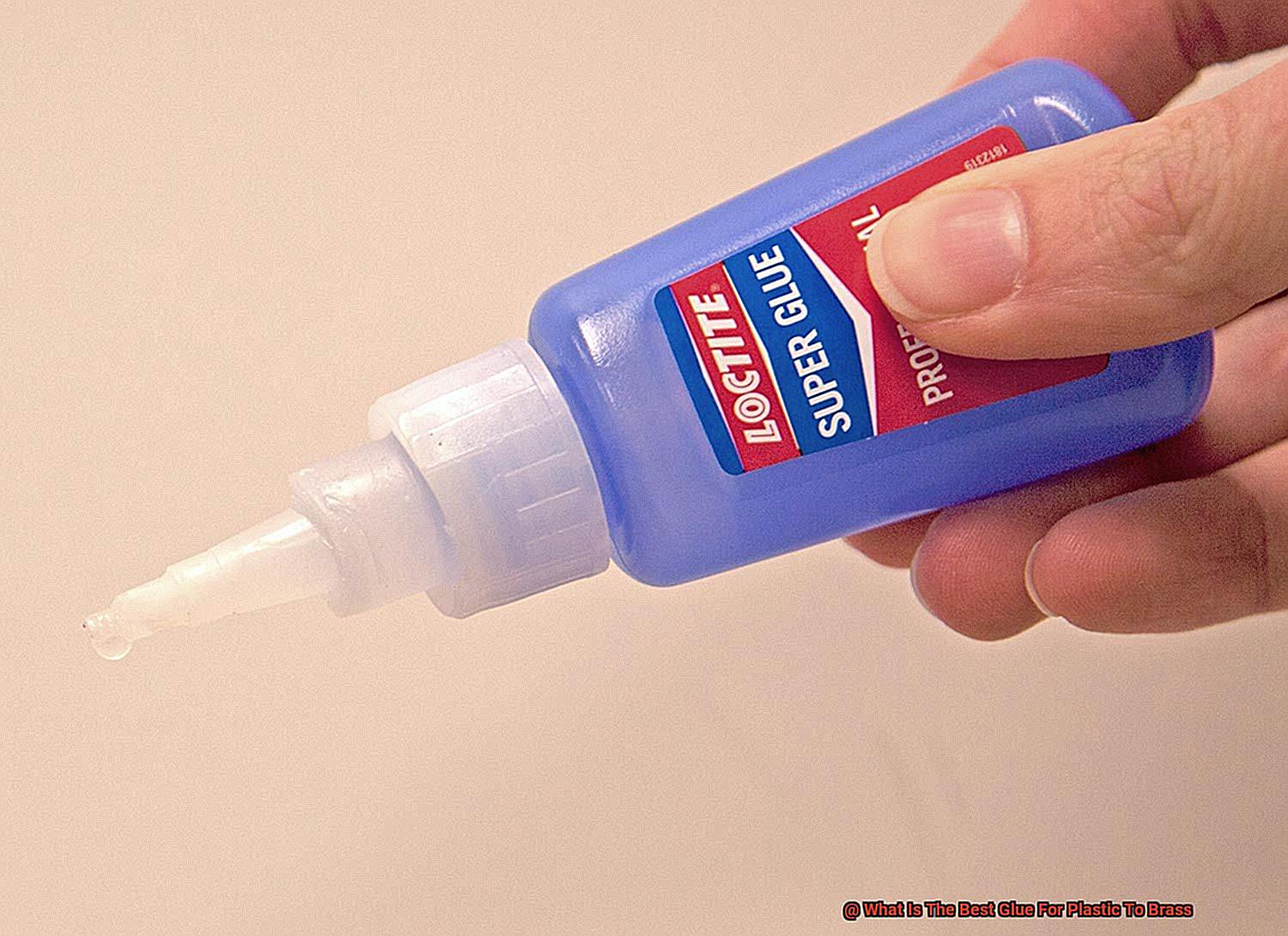
How you apply the adhesive is another vital consideration. Some adhesives require mixing before application, while others come in convenient applicators like tubes or pens. The ease of application can impact the overall bonding process and your level of satisfaction with the results.
Proper Surface Preparation:
To ensure a strong bond, thorough surface preparation is essential. Cleaning the surfaces with a suitable solvent or degreaser removes any dirt, grease, or contaminants that could hinder adhesion. A clean surface provides optimal conditions for the adhesive to form a strong bond.
Time, Temperature, and Testing:
Time and temperature play a crucial role in the bonding process. Some adhesives require curing or drying time before achieving maximum strength, while others may be affected by extreme temperatures. It’s important to follow the manufacturer’s instructions regarding curing time and temperature requirements. Additionally, testing the bond strength before relying on it completely is recommended. Applying a small amount of force or subjecting the bond to relevant conditions will help ensure its durability.
Considerations for Longevity:
While adhesive bonding can create a strong bond between plastic and brass, it’s important to note that it may not always be permanent or suitable for all applications. Factors such as exposure to moisture, chemicals, or high temperatures can weaken the bond over time. In such cases, mechanical fasteners or alternative joining methods might be more appropriate.
Epoxy: A Versatile and Strong Adhesive Solution
When it comes to bonding plastic to brass, finding the perfect adhesive can be a challenge. However, epoxy adhesive comes to the rescue with its versatility and incredible strength. This two-part adhesive consists of a resin and a hardener, which, when combined, create a powerful bond that can withstand high temperatures, moisture, and other environmental factors.
One of the reasons why epoxy is highly regarded for bonding plastic to brass is its exceptional adhesion properties. Unlike other adhesives that struggle to stick to these two materials, epoxy forms a robust bond that ensures a long-lasting connection. But achieving optimal adhesion requires proper surface preparation. Before applying epoxy, it is crucial to clean and roughen the surfaces of both the plastic and brass. This step increases the contact area and enhances the overall bond strength.
Using epoxy to bond plastic to brass is a straightforward process. Simply follow the manufacturer’s instructions regarding the mixing ratio, application technique, and curing time. Depending on the size and shape of the surfaces being bonded, epoxy can be applied using a brush, spatula, or syringe.
After applying the epoxy, it is important to let it cure undisturbed. Epoxy has a longer curing time compared to other adhesives, typically taking several hours to fully harden. However, this extra waiting time is well worth it for the strong and durable bond that epoxy provides.
Once the epoxy has cured, you can further finish or paint the bonded plastic and brass as desired. This allows you to seamlessly integrate your bonded components into your project without compromising aesthetics or functionality.
While epoxy is an ideal choice for bonding plastic to brass, its versatility extends far beyond this application. It is widely used in automotive repairs, construction projects, crafts, and more. Its ability to withstand various environmental factors and its ease of use make it the go-to choice for many DIY enthusiasts and professionals alike.
Super Glue: Fast-Curing and Strong Bond Strength
When it comes to joining plastic and brass, one adhesive stands out from the rest – super glue. Also known as cyanoacrylate adhesive, this fast-curing and strong bonding agent has become the go-to option for various applications. In this article, we’ll explore why super glue is the ultimate choice for bonding plastic to brass, diving into its rapid-curing properties, exceptional bond strength, proper application techniques, and limitations to consider.
Fast-Curing Properties:
Super glue’s most remarkable feature lies in its lightning-fast curing time. Within seconds of application, it sets and forms an unbreakable bond. This attribute makes it especially useful for small-scale projects or urgent repairs where time is of the essence. No more waiting around for hours – super glue gets the job done quickly and efficiently.
Strong Bond Strength:
One of the key reasons why super glue excels in plastic-to-brass bonding is its unparalleled bond strength. Once cured, it creates a rigid connection that can withstand impact and vibration. This makes it ideal for applications that require durability and longevity. Whether you’re repairing a broken plastic handle on a brass tool or crafting intricate model parts, super glue ensures a secure and long-lasting bond.
Proper Surface Preparation:
Achieving a successful bond between plastic and brass using super glue requires proper surface preparation. Both surfaces must be meticulously cleaned and free from contaminants such as dirt or grease. To enhance adhesion, it’s recommended to lightly roughen up the surfaces with sandpaper before applying the adhesive. This step ensures maximum contact between the glue and the materials being bonded, guaranteeing a strong and reliable connection.
Application Techniques:
Applying super glue correctly is crucial for optimal results. Start by applying a small amount of glue to one surface, then firmly press the two surfaces together for a few seconds. The pressure helps distribute the adhesive evenly, ensuring a secure bond. Excess glue should be wiped away immediately to prevent unsightly residue. Remember to test a small area first to ensure compatibility between the glue and the materials being bonded.
Limitations:
While super glue offers many advantages, it also has its limitations. It may not be suitable for all types of plastics and brass. Additionally, over time, super glue can become brittle and lose its adhesive properties at high temperatures. Thus, for applications requiring flexibility or heat resistance, alternative adhesive options like epoxy or polyurethane-based adhesives may be more suitable.
Polyurethane-Based Adhesives: Flexible and Resistant to Temperature Fluctuations
Look no further. Polyurethane-based adhesives are here to save the day. With their incredible flexibility and resistance to temperature fluctuations, these adhesives are the ultimate glue for bonding plastic to brass in various industries. Let’s explore the advantages of using polyurethane-based adhesives and discover why they are the dynamic duo you need.
Flexibility that Saves the Day:
Polyurethane-based adhesives are like acrobats in the adhesive world. They can bend, stretch, and handle vibrations without compromising the bond. From automotive components to electronic devices, these adhesives provide a strong and durable connection that can withstand any action-packed situation.
Temperature Resistant Warriors:
Extreme weather conditions got you worried? Fear not. Polyurethane-based adhesives are designed to face scorching heat and freezing cold temperatures head-on. Whether it’s outdoor equipment or industrial machinery, these adhesives won’t back down from any temperature challenge.
The Chemistry Behind Success:
The secret behind the incredible flexibility and temperature resistance lies in the chemical composition of polyurethane-based adhesives. A powerful blend of isocyanates and polyols reacts together, creating a bond that can withstand extreme conditions. It’s like having a superhero team-up in every adhesive tube.
Material Compatibility at Its Best:
Polyurethane-based adhesives are versatile champions when it comes to bonding different materials. From plastics like PVC, ABS, and polycarbonate to brass surfaces, these adhesives can create a strong connection between them all. No more worrying about compatibility issues – polyurethane has got you covered.
Surface Preparation for Victory:
To ensure maximum bonding strength, proper surface preparation is key. Cleanliness is crucial, so make sure both the plastic and brass surfaces are free from dirt, grease, or oxidation. For an extra boost, roughening the surfaces with sandpaper or using a primer designed for bonding plastics and metals can take your adhesive game to the next level.
Preparing the Surfaces Before Applying Any Adhesive
Properly preparing the surfaces before applying any adhesive is essential for creating a strong and long-lasting bond between plastic and brass. The first step in this process is to thoroughly clean the surfaces. Any dirt, dust, grease, or other contaminants present on the surfaces can interfere with the bonding process and weaken the connection. To clean the surfaces, it is recommended to use a mild detergent or soap solution with water. Avoid using harsh chemicals that could potentially damage the materials.
After cleaning, it is crucial to ensure that the surfaces are completely dry. Moisture can hinder the adhesive’s ability to bond effectively, so it is important to use a clean cloth or allow the surfaces to air dry before proceeding. Patience is key in this step, as rushing could compromise the bond.
In some cases, roughening up the surfaces slightly can improve adhesion. This can be achieved by lightly sanding both the plastic and brass surfaces using fine-grit sandpaper. This creates a slightly roughened texture that gives the adhesive something to grip onto, enhancing its strength and durability. Think of it as giving your bond a little handhold for extra support.
Once the surfaces are cleaned and prepared, it is important to ensure that they are free of any loose particles or debris. Even small particles can interfere with the bonding process, so using a clean brush or compressed air to remove any remaining dust or particles is necessary.
It’s worth noting that some adhesives may require additional surface treatments such as priming or etching, depending on the specific materials being bonded. It is crucial to read and follow the manufacturer’s instructions for the adhesive being used to determine if any additional steps are needed.
Lastly, before applying the adhesive, it is vital to double-check that both the plastic and brass surfaces are bone dry. Any lingering moisture can seriously compromise the bond strength and durability. Taking this extra time to ensure dryness will pay off in the long run, as it will contribute to a stronger and more reliable bond.
Testing the Adhesive on a Small Area First
Glue, the unsung hero of our everyday lives, has the power to fix and create. But when it comes to bonding plastic to brass, there’s one step that should never be overlooked: testing the adhesive on a small area first. In this blog post, we will explore the importance of this step and how it helps us achieve a sturdy and lasting bond.
Compatibility Testing:
Plastic and brass, two distinct materials with unique properties, require an adhesive that can adhere well to both surfaces. By testing the adhesive on a small, inconspicuous area, we can determine its compatibility with plastic and brass. This ensures that we choose the right adhesive for the job and avoid any potential bonding failures.
Minimizing Damage:
Imagine spending hours crafting a beautiful piece, only to have the adhesive damage or discolor it. Testing the adhesive on a small area allows us to minimize potential damage or discoloration. By selecting an inconspicuous area like an underside or hidden corner, we can limit any negative effects to a small, less visible area.
Assessing Bond Strength:
The ultimate goal of gluing plastic to brass is creating a strong and durable bond. By testing the adhesive on a small area, we can evaluate its bond strength. We should look for signs of proper adhesion, such as a solid connection between the plastic and brass without any visible gaps or separation. This step gives us confidence in the adhesive’s ability to create a long-lasting bond.
Material-specific Considerations:
Different types of plastics and brass alloys may react differently to adhesives. What works for one combination may not work for another. Testing multiple adhesives on various plastic and brass combinations helps us determine which one suits our specific project best.
Considering Application Requirements
In the world of crafting and fixing, one challenge often arises – how to bond plastic and brass together. While it may seem simple, achieving a strong and durable bond requires careful consideration of the application requirements. In this blog post, we will explore why it is crucial to consider these requirements when choosing the best glue for bonding plastic to brass.
Material Compatibility:
Before selecting a glue, it is essential to consider the type of plastic and brass involved. Different plastics and brass alloys have unique chemical compositions and surface finishes that can greatly affect the adhesive’s effectiveness. For example, polyethylene plastics require a different adhesive than polycarbonate plastics. By understanding the specific materials being used, you can choose a glue that is compatible with both plastic and brass, ensuring a reliable bond.
Environmental Conditions:
The intended use and environmental conditions of the bonded assembly play a significant role in determining the suitable glue. Will it be exposed to moisture, high temperatures, or constant movement? These factors can impact the adhesive’s performance and lifespan. For instance, if the bonded assembly will be exposed to water, a waterproof or moisture-resistant adhesive is essential to prevent weakening or failure of the bond.
Strength Requirements:
Consider the desired strength of the bond. Some applications require a high-strength bond capable of withstanding heavy loads or stress, while others may only need a moderate or low-strength bond. Understanding the load-bearing requirements will help you choose a glue that can provide the necessary strength for your specific application.
Ease of Application and Curing Time:
The ease of application and curing time of the glue should also be considered. Some glues may require mixing or multiple steps in their application process, while others come ready-to-use. The curing time is important if you have time constraints or need immediate usability. For example, if you are working on a time-sensitive project, a fast-curing adhesive would be more suitable.
djtKXkTqPUI” >
Also Read: How to Glue Brass to PVC?
Conclusion
In conclusion, when it comes to bonding plastic and brass, there are a few glue options that stand out.
One of the best choices is epoxy adhesive. Its strong bond and versatility make it ideal for joining these two materials together.
Another top contender is cyanoacrylate glue, commonly known as super glue. This fast-acting adhesive forms an instant bond and works well on both plastic and brass surfaces.
Additionally, polyurethane adhesive is worth considering due to its flexibility and durability. It provides a reliable bond that can withstand various conditions.
Ultimately, the best glue for plastic to brass depends on your specific needs and preferences.

